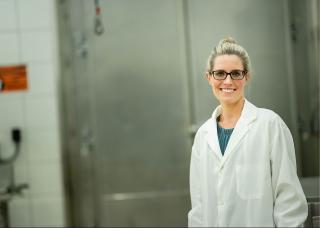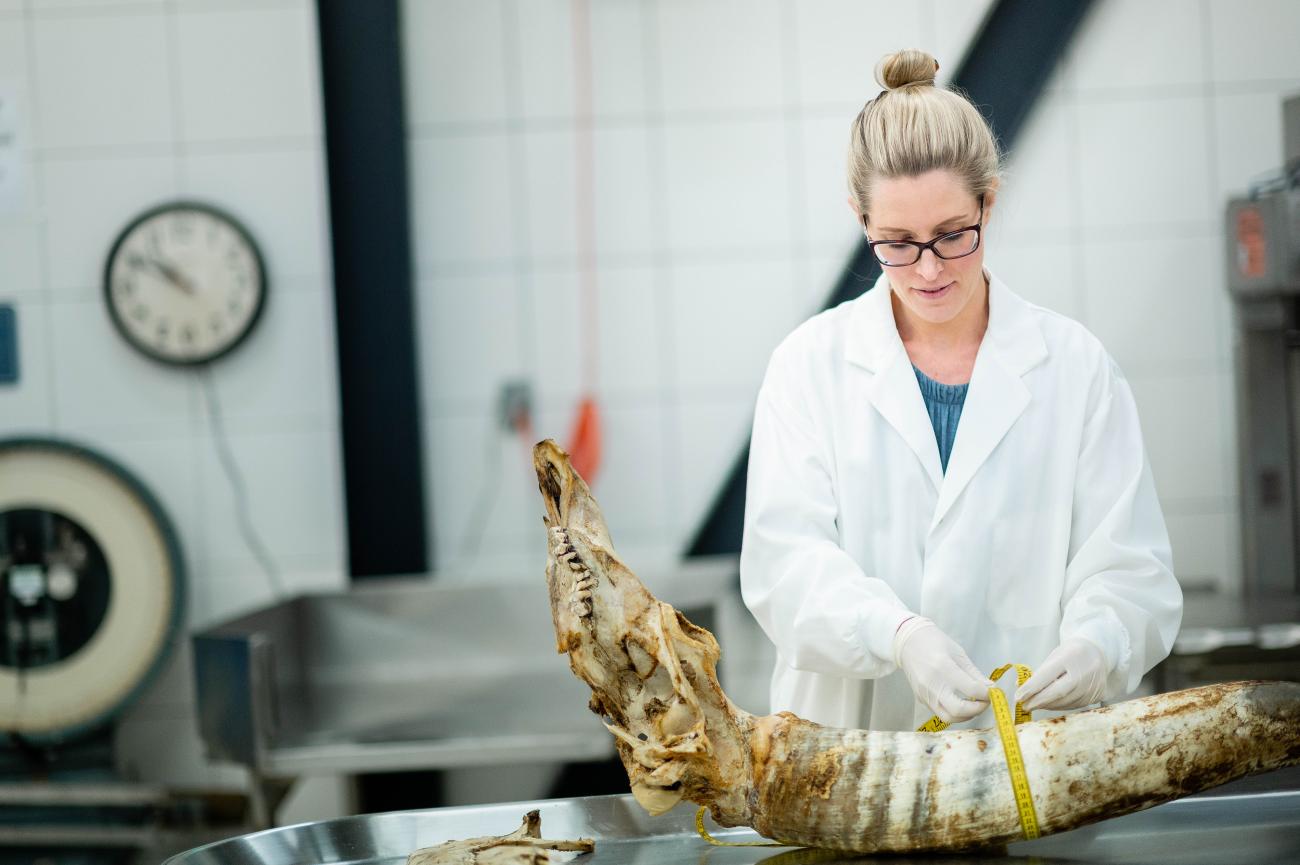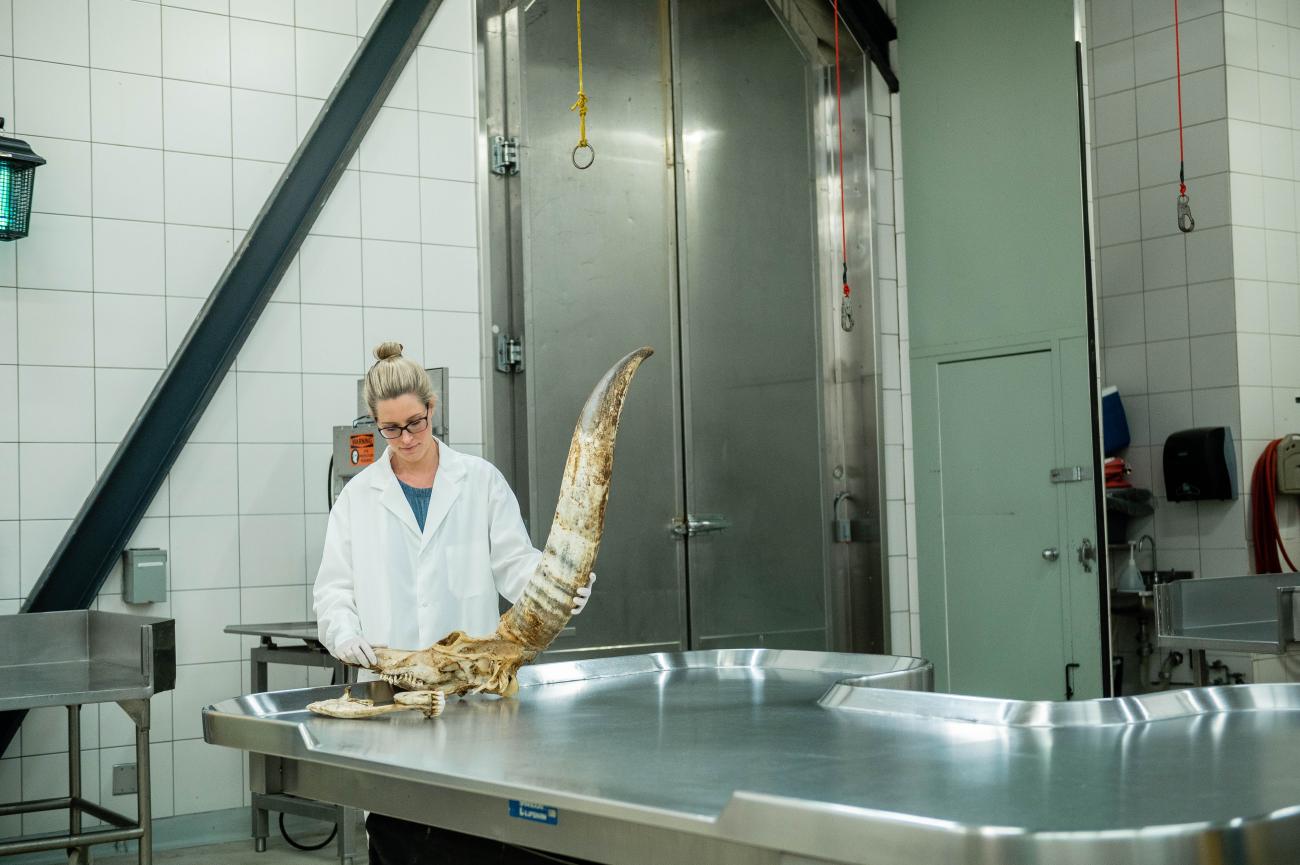Wearing three hats sewn together by a passion for one health


Chelsea Himsworth describes herself as an odd duck at UBC. That is because not only is she a full-time employee of the BC Ministry of Agriculture, but she also conducts UBC teaching and research through a partner track faculty appointment with the UBC Faculty of Medicine’s School of Population and Public Health.
Working in Abbotsford, Chelsea is a practicing veterinary pathologist and the leader of Veterinary Science and Diagnostics at the Ministry’s Animal Health Centre. On top of that, she wears a third hat as the BC Regional Director of the Canadian Wildlife Health Cooperative.
Wearing these different hats has presented Chelsea with important opportunities to apply and contribute to promoting the value of ‘one health’ — a collaborative, trans-disciplinary approach that recognizes we will all do better by looking at the earth as an ecosystem that people, animals and plants all share and are increasingly impacting each other within it.
One example is the Vancouver Rat Project, which started out as a PhD project while she was studying at UBC. It was intended to be a case study to explore how rats interact, absorb and transfer disease in an urban environment, but then it took on a life of its own. She is now working with the City of Vancouver to develop ways to create a healthy city where rats and humans can co-exist.
The great nexus of her three roles was her involvement in creating a valuable new technology for surveilling avian influenza. After repeated surprises case counts, Chelsea realized that the current approach was not sufficient. Surveillance programs in Canada and the US were limited to collecting and testing individual wild birds. She established a collaborative program with the BC Ministry of Agriculture, BC Centre for Disease Control Public Health Laboratory, and UBC to develop a new approach — a genomics-based test that identifies and characterizes avian influenza viruses in wetland sediments.
Chelsea enjoys the collaborative research opportunities that arise from being part of the School of Population and Public Health, but she says that she is most inspired by the students:
“Interacting with students is my #1 driver. In the classroom and through mentorship of graduate students, nothing energizes me more than talking to students about their ideas.”
Interacting with students is my #1 driver. In the classroom and through mentorship of graduate students, nothing energizes me more than talking to students about their ideas.
Chelsea Himsworth

This is not surprising given the role Chelsea’s mentors have had in shaping her career.
Chelsea grew up in Saskatchewan with a passion for horses. She enrolled in the Western College of Veterinary Medicine with a clear intent of becoming an equine veterinarian, but in her final year, a fortuitous contact with her first mentor, Ted Leighton, set her on a new path. He was a maverick whose famous lifeboat article presented veterinary medicine as having a central role in sustaining ecological stability and human well-being within the limits of the biosphere.
“It completely blew my mind,” she said. “This was my first exposure to the ‘one health’ approach, and it instantly changed my career ambitions.”
She changed streams in her last year to veterinary pathology and embarked on a residency working directly with Ted Leighton. There, she acquired new tools and a deep understanding of disease processes in animals.
Another fortuitous event expanded her thinking even further. A doctor who she knew told her that he had thought a child patient of his had a tumour in her brain, but it turned out to be a parasite. Chelsea was able to identify the parasite and explain that it was transmitted to humans through moose hunting and feral dog feces. This launched the two of them into her first one health study. They analyzed the risk of the parasite and worked with communities to mitigate the risks through life practices.
She knew then that this was what she was meant to do and started to look for a PhD program that would allow her to explore the human health side of the equation. After calling numerous universities throughout Canada, she found her next mentor — Professor David Patrick in UBC’s School of Population and Public Health.

“David is one of those life-changing people,” says Chelsea. “It was a crazy jump and a big risk to take me on. I had no knowledge of human health, but he was uniquely open-minded and intellectually brave. His ability to challenge me and his willingness to trust me allowed me to pursue my passion for one health research.”
Looking forward, Chelsea is interested in expanding her network of research collaborators throughout UBC. She is particularly dedicated to trans-disciplinary initiatives involving the integration, adaptation and evolution of tools from different disciplines. It is this sort of cross-pollination that allows true innovation. She is also focused on connecting to and communicating with the public, decision makers, and stakeholders, and is currently teaching a course on risk communication through the School of Population and Public Health.
“The school is one of the most trans-disciplinary, open-minded environments that I have worked in,” says Chelsea. “Everyone has open ears and looks for ways to team together. Now I would love to grow beyond the school and develop collaborative relationships with other Faculties like Land and Food Systems and departments like zoology, sociology, journalism, and beyond! UBC is a fertile environment for ‘one health’ problem solving.”
Find the latest news, updates, events, and useful dates from across UBC, curated for faculty and staff by Internal Communications.
Access a library of resources from multiple UBC websites, all in one place.